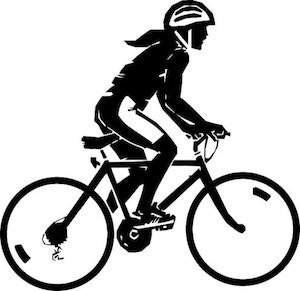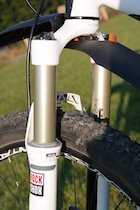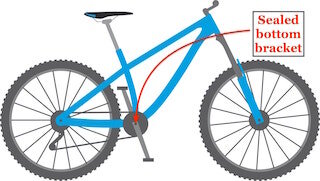Why is a bicycle seat called a saddle?
Bicycles were designed to be a mode of transportation similar to a horse but under the propulsion of man. The motion of mounting and riding a bike is very similar to that of mounting a saddled horse.
Today, bike seats or saddles are used interchangeably and are synonyms. Both terms are used by professionals in the industry, such as bicycle manufacturers, inventors, and historians.
WHY A bicycle SEAT IS CALLED A SADDLE: hobby horse HISTORY
Bicycle seats were originally called saddles. The earliest bicycles were adapted from the hobby-horse or pedestrian accelerator, which was designed in 1817. The hobby horse didn’t have any pedals, as the rider pushed their feet against the ground and rode in the saddle. Most historians consider the hobby horse (wooden draisine) to be the starting point for our modern-day bicycle.
The hobby horse (1817) - Pedals were added to the front wheel about 50 years later
The Hobby Horse consisted of:
Two wooden wheels were connected by a wooden beam, which attached to:
Saddle
Arm support
Chest support
Handlebar
“Unlike walking or running, the Hobby Horse supported some of the subject’s weight with the saddle, and thus afforded substantial energy savings”
bicycle saddle history: The boneshaker & high wheeler
The Boneshaker or Velocipede (1860s)
In the 1860s the hobby horse was improved with the addition of pedals and cranks to the front wheel. This new and improved bicycle was known as the boneshaker or velocipede.
In the 1870s, the high-bicycle or penny-farthering was developed. This is the classic bike with the huge front wheel. The rationale for the enlarged front wheel was that the bicycle would travel further with each pedal stroke since the pedal system was still only attached to the front wheel.
During this time period, which predates the automobile, horses were the primary mode of transportation. You sat in the horse’s saddle and rode the horse, just like on the adapted and updated hobby horse.
The High Wheeler
Mounting and dismounting the high wheeler, as with equestrians, took skill, as the bicycle saddle and horse saddle were significantly higher than the person looking to mount the bicycle or horse.
The average saddle of a high wheeler was 5 feet (1.5 meters) off the ground, and had a mounting step about 2 feet from the ground.
A search through the United States Patent Office during the velocipede and high wheeler era, circa the 1860s - late 1870s, shows that all bike seats are called and patented as saddles.
Interesting note: During the early part of the velocipede era, pedals were called treadles.
bicycle history: the rover & the end of mounting
In the 1880s, the Rover Safety Bicycle appeared, which was the first bicycle to be chain-driven. This eliminated the large front-wheel and was now rear-wheel propelled.
Safety bicycle (late 1880s)
The two main advantages of the Rover:
Steering - Easier to steer the front wheel as it was no longer the propelled (driving) wheel
Mounting/Dismounting - Mounting and dismounting were basically eliminated, as one could just hop on and off with ease
Bicycle-seat patent from January 12th, 1886 (additional markings are mine)
In 1895, Arthur Peck applied for a bicycle saddle patent and noted: “My invention relates to the improvements in Bicycle-Saddles, or more properly speaking, bicycle-seats.”
Starting in about 1882, bicycle seat was becoming a standardized term and was being used in place of bicycle saddle.
In the early-1880s, several patents were filed as the term seat was becoming standard bicycle terminology.
BIKE SEAT = SADDLE
I contacted Joe Breeze, the inventor of the mountain bike and curator of the Marin Museum of Bicycling in California about bicycle saddles and seats. Joe Breeze said, “the names are interchangeable.”
I also contacted Yeti Cycles and Trek, and both bicycle manufactures said that saddle and seat are interchangeable terms.
bicycle seat post, seat tube & binder bolt
All bicycles have a seat post, which is inserted into the seat tube and held together by a seat post binder bolt.
These seat post components are never called saddle post, saddle tube or saddle post binder bolt.
Let us also not forget the seat tube angle, which is the angle between the ground and the seat tube.
Sheldon Brown & seat vs saddle
Sheldon Brown, the famed bicycle mechanic and author had this to say on his website, Sheldon Brown's Bicycle Technical Info about saddles and seats:
A seat is something you sit on, and is designed to bear essentially your entire weight. Recumbent bicycles have seats, but conventional upright bicycles have saddles. A saddle is intended to carry some, but not all of your weight.
- From Sheldon Brown’s website
It should be noted that saddles were originally designed to assist in mounting the horse and provide the rider with balance. If you have ever ridden a horse, then you know how difficult it can be to mount such a large animal.
Sheldon’s primary point of differentiation:
Seat bears all your weight
Saddle only supports part of your weight
Sheldon’s main differentiation between the seat and saddle is quite flawed, since:
A seat is a place to sit
A saddle is a seat fastened to an animal or in our case a bicycle
Final thought
Words are fluid and dynamic and change meaning over time. Whether you call the thing you sit on while riding, a seat or a saddle is really not so important. Words are used so we can communicate with each other by sharing thoughts and ideas. Seats and saddles communicate the same message and allows us to share the joy we find through pedaling bikes.
Famed bicycle historian, David V. Herlihy's wrote a response to this article. You can read his response on this website by clicking here.
Jesse is Director of Pedal Chile and lives in Valdivia, Chile. Jesse has a Master of Science in Health and Human Performance and is an avid MTBer, backpacker, snowboarder and enjoys reading and researching. I use both terms: saddle and seat, which depends on the person I’m talking with.
Sources and references:
Minetti, A.E., Pinkerton, J. and Zamparo, P. (2001). From bipedalism to bicyclism: evolution in energetics and biomechanics of historic bicycles. Proceedings of the Royal Society of London. Series B: Biological Sciences, 268(1474), pp.1351–1360.
Smithsonian Institution. (n.d.). bicycle, safety.
Smithsonian Institution. (n.d.). Draisine, ca. 1818.
Smithsonian Institution. (n.d.). Child’s High Wheel Bicycle, 1885.
Smithsonian Institution. (n.d.). Velocipede, 1868.




























